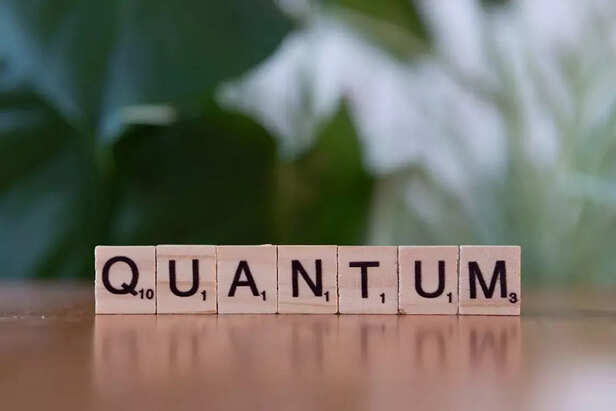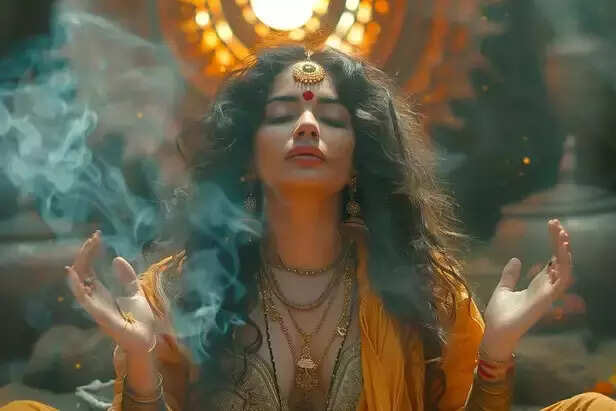5 Things Sanatana Dharma Knew Before Science Did!
Nidhi | Apr 10, 2025, 01:48 IST
( Image credit : Pexels, Timeslife )
Long before telescopes, equations, or lab experiments, Sanatana Dharma offered profound insights into the nature of reality, energy, consciousness, and the cosmos. Rooted in meditation, observation, and inner science, this ancient Indian wisdom system whispered truths that modern science is only now beginning to validate. From concepts resembling quantum physics to the deep connection between breath and mind, discover five fascinating truths Sanatana Dharma knew ages before they made headlines in research journals.
What if I told you your grandma’s prayers, your dad’s morning Om, and that dusty Bhagavad Gita on the shelf were dropping quantum truths long before physicists did?
Yep. While lab coats were still centuries away, sages in loincloths were meditating under peepal trees and scribbling down the universe’s secrets on palm leaves. No fancy tech. No satellites. Just stillness, silence, and some serious soul science.
Sanatana Dharma—the eternal path of truth, duty, and cosmic rhythm—was never just a religion. It was, and still is, a living science. A science of being, not just doing. It doesn't need equations to prove what it already knows in the marrow of its ancient bones. And the wildest part? Modern science is just now catching up.
So let’s time-travel through five profound truths that Sanatana Dharma whispered eons ago—truths that science is only beginning to shout from lab rooftops today.

Long before string theory and energy fields were trending in physics journals, the Upanishads had already sung the mantra: Sarvam khalvidam Brahma—everything is Brahman. Everything is one. Your thoughts, this screen, that tree outside your window—it’s all vibrating with the same divine frequency. Even “Om” isn’t just a sound—it’s the vibration that echoes the Big Bang.
Scientific Echo:
Quantum physics now confirms: matter is not solid; it's energy in motion. Atoms are mostly empty space, and particles exist as waves of potential until observed. Energy isn't just in the universe—it is the universe.
Ever walked into a room and felt the energy shift? That’s not just vibes—it’s physics. Sanatana Dharma didn’t just describe energy. It taught us how to flow with it.

Spiritual Take:
Your mind isn’t just a place for overthinking—it’s a control room. In yoga and Ayurveda, breath and thought are medicine. Stress? It’s not a villain from the modern world—it’s an age-old concept known to disrupt your doshas, your energies. That’s why meditation, pranayama, and chanting were prescribed not as religious rituals, but as inner engineering.
Scientific Echo:
Now, neuroscience and psychology agree: stress triggers inflammation, weakens immunity, and can mess with everything from your skin to your sleep. On the flip side, mindfulness and meditation can literally rewire your brain.
Your body listens to every word your mind says. Sanatana Dharma didn’t just tell us to “calm down”—it gave us the tools to do it.
 The Bhagavad Gita says the soul changes bodies like clothes—death isn’t an end, but a pause. In Sanatana Dharma, rebirth is evolution, not punishment. Every life is a chance to grow, shed karma, and move closer to liberation (moksha). Your déjà vu, gut instincts, or strange connections? They might just be memories from past journeys.
The Bhagavad Gita says the soul changes bodies like clothes—death isn’t an end, but a pause. In Sanatana Dharma, rebirth is evolution, not punishment. Every life is a chance to grow, shed karma, and move closer to liberation (moksha). Your déjà vu, gut instincts, or strange connections? They might just be memories from past journeys.
Scientific Echo
Researchers like Dr. Ian Stevenson and Dr. Jim Tucker have documented thousands of children recalling past lives with shocking detail. Near-death experiences and quantum theories now suggest that consciousness might exist beyond the brain. Science is slowly circling back to what sages knew all along—our soul may be more than biology.
Have you ever met someone who felt uncannily familiar? Or had déjà vu that gave you goosebumps? Maybe your soul is trying to remind you—this isn’t your first dance on Earth.

In Sanatana Dharma, nature isn’t “natural resources.” It’s divine presence. Rivers are goddesses, animals are sacred, and even mountains have moods. Vasudhaiva Kutumbakam—“The world is one family.” You aren’t above nature—you are nature.
Scientific Echo:
Ecology proves we’re not just part of an ecosystem—we are the ecosystem. Disrupt bees, lose food chains. Pollute air, damage lungs. Even quantum entanglement shows how particles stay connected across the universe.
We don’t need to dominate Earth. We need to remember we’re made of it. The soil in your garden shares atoms with your bones. Worshipping nature wasn’t superstition—it was sophisticated sustainability.

Close your eyes. Breathe in deeply. Exhale slowly. That’s not just air—it’s prana, your life force. Ancient yogis knew breath controls not just the body, but the mind and soul. Through pranayama, they accessed clarity, balance, even higher states of consciousness—long before the word “biohacking” existed.
Scientific Echo:
Modern research confirms it: deep, conscious breathing activates your parasympathetic nervous system, easing anxiety, improving focus, and boosting emotional control. From therapy to Navy SEAL training, ancient techniques like box breathing and nadi shodhana are now mainstream.
Your breath is your anchor. Whether you're heartbroken, anxious, or just stuck in traffic—your breath can bring you home to yourself.
Sanatana Dharma isn’t something buried in temples or scriptures—it’s alive in your breath, your heartbeat, your quiet moments of wonder. It doesn’t need science’s validation. But isn’t it poetic that the very instruments we built to explain the universe are now pointing toward the truths our ancestors felt with their eyes closed?
This isn’t about choosing between science or spirituality. It’s about recognizing that the universe speaks more than one language—and Sanatana Dharma just happened to be fluent in it first.
So the next time you chant “Om,” light a diya, or sit quietly in meditation—remember: you’re not practicing something ancient.
You’re practicing something eternal.
Yep. While lab coats were still centuries away, sages in loincloths were meditating under peepal trees and scribbling down the universe’s secrets on palm leaves. No fancy tech. No satellites. Just stillness, silence, and some serious soul science.
Sanatana Dharma—the eternal path of truth, duty, and cosmic rhythm—was never just a religion. It was, and still is, a living science. A science of being, not just doing. It doesn't need equations to prove what it already knows in the marrow of its ancient bones. And the wildest part? Modern science is just now catching up.
So let’s time-travel through five profound truths that Sanatana Dharma whispered eons ago—truths that science is only beginning to shout from lab rooftops today.
1. Everything Is Energy: "Sarvam Khalvidam Brahma"

Quantum physics
( Image credit : Pexels )
Long before string theory and energy fields were trending in physics journals, the Upanishads had already sung the mantra: Sarvam khalvidam Brahma—everything is Brahman. Everything is one. Your thoughts, this screen, that tree outside your window—it’s all vibrating with the same divine frequency. Even “Om” isn’t just a sound—it’s the vibration that echoes the Big Bang.
Scientific Echo:
Quantum physics now confirms: matter is not solid; it's energy in motion. Atoms are mostly empty space, and particles exist as waves of potential until observed. Energy isn't just in the universe—it is the universe.
Ever walked into a room and felt the energy shift? That’s not just vibes—it’s physics. Sanatana Dharma didn’t just describe energy. It taught us how to flow with it.
2. Your Mind Can Heal—or Harm—Your Body

neuroscience
( Image credit : Pexels )
Spiritual Take:
Your mind isn’t just a place for overthinking—it’s a control room. In yoga and Ayurveda, breath and thought are medicine. Stress? It’s not a villain from the modern world—it’s an age-old concept known to disrupt your doshas, your energies. That’s why meditation, pranayama, and chanting were prescribed not as religious rituals, but as inner engineering.
Scientific Echo:
Now, neuroscience and psychology agree: stress triggers inflammation, weakens immunity, and can mess with everything from your skin to your sleep. On the flip side, mindfulness and meditation can literally rewire your brain.
Your body listens to every word your mind says. Sanatana Dharma didn’t just tell us to “calm down”—it gave us the tools to do it.
3. Rebirth Isn’t Just a Mythical Plot Twist

UNO reverse
( Image credit : Pexels )
Researchers like Dr. Ian Stevenson and Dr. Jim Tucker have documented thousands of children recalling past lives with shocking detail. Near-death experiences and quantum theories now suggest that consciousness might exist beyond the brain. Science is slowly circling back to what sages knew all along—our soul may be more than biology.
Have you ever met someone who felt uncannily familiar? Or had déjà vu that gave you goosebumps? Maybe your soul is trying to remind you—this isn’t your first dance on Earth.
4. Nature Isn’t Outside You—It Is You

Self Awareness
( Image credit : Pexels )
In Sanatana Dharma, nature isn’t “natural resources.” It’s divine presence. Rivers are goddesses, animals are sacred, and even mountains have moods. Vasudhaiva Kutumbakam—“The world is one family.” You aren’t above nature—you are nature.
Scientific Echo:
Ecology proves we’re not just part of an ecosystem—we are the ecosystem. Disrupt bees, lose food chains. Pollute air, damage lungs. Even quantum entanglement shows how particles stay connected across the universe.
We don’t need to dominate Earth. We need to remember we’re made of it. The soil in your garden shares atoms with your bones. Worshipping nature wasn’t superstition—it was sophisticated sustainability.
5. Breath Is the Remote Control to the Mind

Yoga
( Image credit : Pexels )
Close your eyes. Breathe in deeply. Exhale slowly. That’s not just air—it’s prana, your life force. Ancient yogis knew breath controls not just the body, but the mind and soul. Through pranayama, they accessed clarity, balance, even higher states of consciousness—long before the word “biohacking” existed.
Scientific Echo:
Modern research confirms it: deep, conscious breathing activates your parasympathetic nervous system, easing anxiety, improving focus, and boosting emotional control. From therapy to Navy SEAL training, ancient techniques like box breathing and nadi shodhana are now mainstream.
Your breath is your anchor. Whether you're heartbroken, anxious, or just stuck in traffic—your breath can bring you home to yourself.
When Ancient Meets Atomic
This isn’t about choosing between science or spirituality. It’s about recognizing that the universe speaks more than one language—and Sanatana Dharma just happened to be fluent in it first.
So the next time you chant “Om,” light a diya, or sit quietly in meditation—remember: you’re not practicing something ancient.
You’re practicing something eternal.
